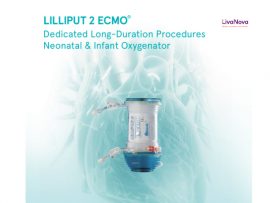Abstract Every year, more and more adults and children with severe cardiac and/or respiratory failure require connection to extracorporeal circulation (ECC). Despite a life-saving role in emergency settings, the use..
Read MoreAbstract We are grateful for the readers’ interest and suggestions relevant to our original contribution entitled “Pulmonary Artery Dual-Lumen Cannulation Versus Two Cannula Percutaneous Extracorporeal Membrane Oxygenation Configuration in Right..
Read MoreAbstract Extracorporeal circulation (ECC) procedures, such as cardiopulmonary bypass (CPB) and extracorporeal membrane oxygenation (ECMO), take over the function of one or more organs, providing clinicians time to treat underlying..
Read MoreAbstract 71.759 surgical procedures were performed in 2019 with the aid of cardiopulmonary bypass in Germany. To adjust the patient’s body temperature on extracorporeal circulation, the application of a heater-cooler..
Read MoreAbstract Objective To investigate the effects of dopamine on the adverse pulmonary changes following cardiopulmonary bypass Design Prospective, nonrandomized clinical investigation Setting University hospital Participants One hundred and fifty-seven patients..
Read MoreAbstract Introduction: Despite extensive evidence that shows clinical of superiority of MiECC, worldwide penetration remains low due to concerns regarding air handling and volume management in the context of a..
Read MoreAbstract Postcardiotomy shock (PCS) has historically been associated with substantial morbidity and mortality. Mortality at discharge is reportedly more than 60%. We investigated the outcomes of our standardized approach to..
Read MoreAbstract Background Intermittent antegrade cold-blood cardioplegia followed by terminal warm-blood cardioplegic reperfusion or hot-shot is reported to reduce myocardial injury in the setting of coronary surgery. The efficacy of this..
Read MoreAbstract Objective after cardiac surgery can be difficult to assess, often requiring invasive measurements. Bioelectrical impedance vector analysis (BIVA) is based on patterns of resistance (R) and reactance (Xc), corrected..
Read MoreAbstract Clotting, anticoagulation, platelet consumption, and poor platelet function are major factors in clinical extracorporeal circulation (ECC). We have shown that nitric oxide-releasing (NOReL) coatings prevent thrombosis in a rabbit..
Read MoreAbstract Development of minimally invasive cardiac surgery (MICS) served the purpose of performing surgery while avoiding the surgical stress triggered by a full median sternotomy. Minimizing surgical trauma is associated..
Read MoreAbstract Objective: Acute kidney injury (AKI) is a major complication after cardiovascular surgery. The unclear etiology of this highly complex event challenges definition, diagnosis and prediction of AKI, and hence..
Read MoreAbstract Introduction: Coagulopathy after cardiac surgery is a serious multifactorial complication that results in postoperative bleeding requiring transfusion of red blood cells and procoagulant products. Use of cardiopulmonary bypass represents..
Read MoreAbstract Introduction: Despite low mortality, cardiac surgery patients may experience serious life-threatening post-operative complications, often due to extracorporeal circulation and reperfusion. Miniaturised cardiopulmonary bypass (minimally invasive extracorporeal circulation) has been..
Read MoreRESUMEN La vía final común de los efectos de la circulación extracorpórea es la hipoperfusión periférica, que se valora indirectamente a través de la utilización de O2 en la periferia. El Orthogonal..
Read MoreRESUMEN La incidencia de lesiones neurológicas graves tras la cirugía cardíaca se ha establecido en un 6,1%: un 3,1% de lesiones focales y un 3% de lesiones difusas. Parece que..
Read MoreAbstract The storytelling of contemporary cardiac surgery is narrated from early extra cardiac procedures to open heart surgery. The Italian author, Dr. Tesler, has been a testimonial of any step...
Read MoreAbstract Objective: To test the capacity of the Logistic CASUS Score on the second postoperative day, the total serum bilirubin dosage on the second postoperative day and the extracorporeal circulation..
Read MoreAbstract OBJECTIVES Heparin-induced thrombocytopenia (HIT) requires alternative anticoagulation strategies. We investigated outcomes in patients with HIT antibodies undergoing low-dose bivalirudin anticoagulation during left ventricular assist device implantation on an extracorporeal..
Read MoreAbstract The overwhelming success of cardiac surgery is closely related to the development and use of extracorporeal perfusion. After the first successful treatment of a stab wound to the heart..
Read MoreAbstract OBJECTIVES: Extracorporeal membrane oxygenation (ECMO) is a lifesaving but expensive therapy in terms of financial, technical and human resources. We report our experience with a ‘basic’ ECMO support model,..
Read MoreAbstract Extracorporeal membrane oxygenation (ECMO) has emerged as an invaluable tool for bridging severe isolated or combined failure of lung and heart. Due to massive technical improvements, the application of..
Read MoreAbstract Minimal invasive extracorporeal circulation (MiECC) systems have initiated important efforts within science and technology to further improve the biocompatibility of cardiopulmonary bypass components to minimize the adverse effects and..
Read MoreAbstract Objective: Extracorporeal membrane oxygenation has been used in patients with severe circulatory or respiratory failure since the 1970s, but the knowledge on long-term survival in this group is scarce...
Read MoreAbstract Purpose Hemorrhage is the most common cause of preventable death after trauma. Coagulopathy plays a central role in uncontrolled bleeding and is caused by multiple factors. Extracorporeal Membrane Oxygenation..
Read MoreAbstract Background This retrospective single-center study aimed to analyze transfusion requirements, coagulation parameters, and outcome parameters in patients undergoing lung transplantation (LuTx) with intraoperative extracorporeal circulatory support, comparing cardiopulmonary bypass..
Read MoreAbstract Computational numerical analysis was performed to elucidate the flow dynamics of femoral artery perfusion. Numerical simulation of blood flow was performed from the right femoral artery in an aortic..
Read MoreAbstract Blood-contacting devices, including extracorporeal circulation (ECC) circuits, can suffer from complications due to platelet activation and thrombus formation. Development of nitric oxide (NO) releasing polymers is one method to..
Read MoreAbstract Introduction: Arterial filter is the part of the cardiopulmonary bypass circuit where blood cells are exposed to high mechanical stress and where cellular aggregates may fasten in large quantities...
Read More

















